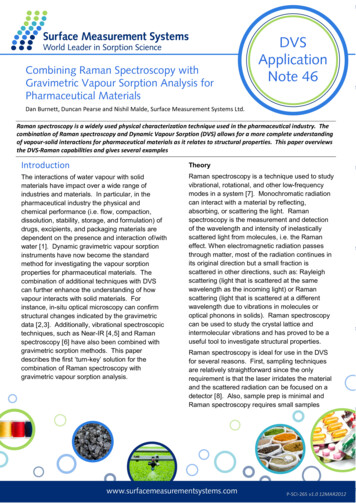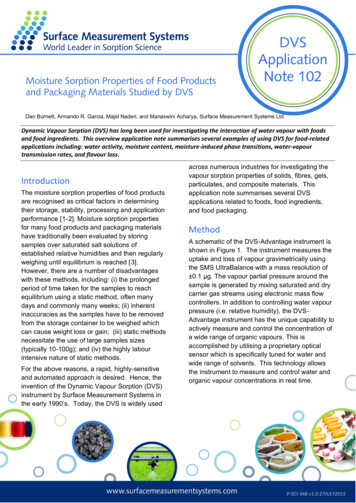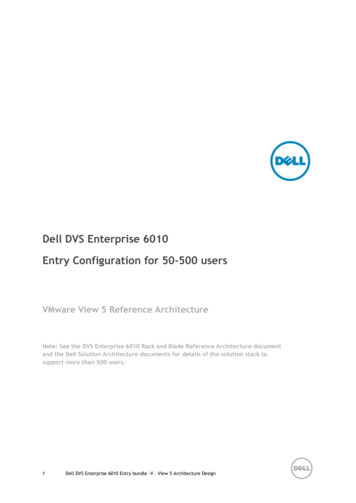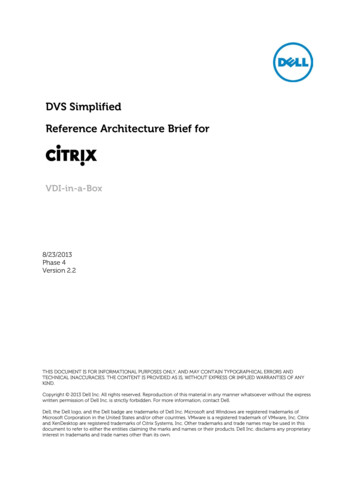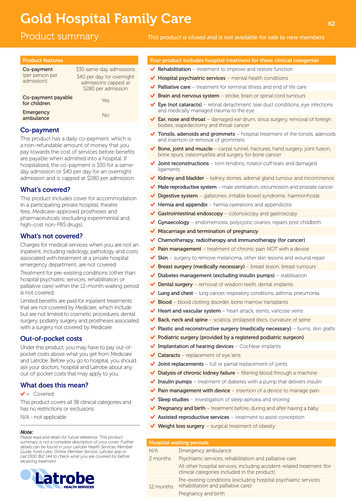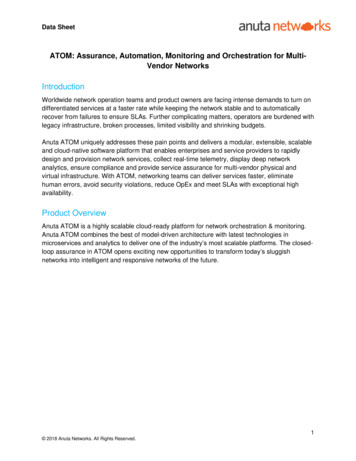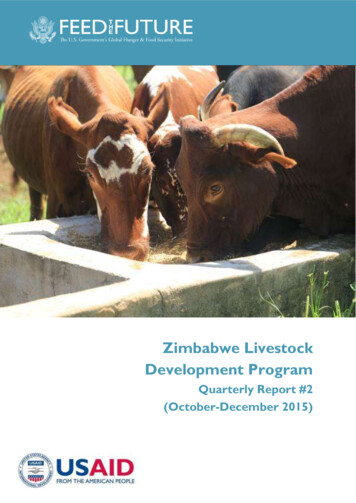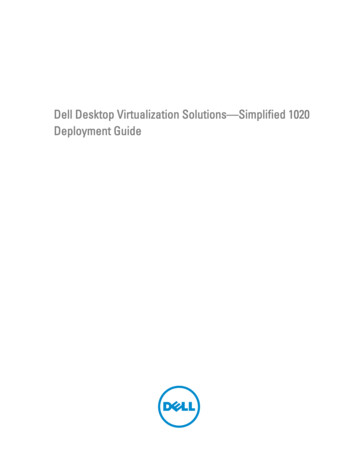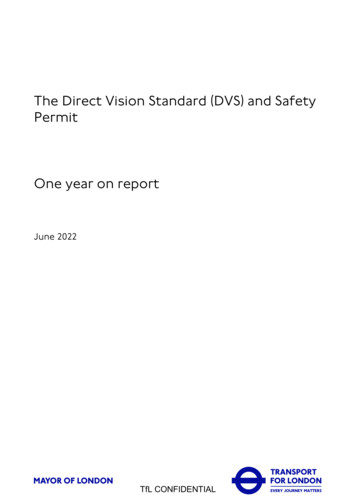
Transcription
The Direct Vision Standard (DVS) and SafetyPermitOne year on reportJune 2022TfL CONFIDENTIAL
2TfL CONFIDENTIAL
ContentsExecutive summary . 5123456Introduction . 61.1Scope . 61.2Overview of current scheme . 61.3Data limitations . 8The DVS and HGV Safety Permit. 92.1Policy context: Direct vision and road danger reduction . 92.2Developing DVS and the Safe System . 10Enforcing DVS: First year overview . 123.1Scheme overview . 123.2Enforcing DVS . 14Analysis of collision data . 164.1Trends of collisions involving HGVs. 164.2Collisions since the start of DVS enforcement . 19The next phase of development for DVS . 205.1Commitment to Phase 2 . 205.2The Progressive Safe System (PSS) . 205.3TfL leading the way at UK and EU level . 21Conclusion . 223TfL CONFIDENTIAL
Table of figuresFigure 1 Operational DVS area. . 7Figure 2 0* star rated HGVs - Safe System requirements . 7Figure 3 DVS permits issues by star rating . 12Figure 4 PCNs issued by month during the first year of enforcement . 15Figure 5 CPOS roadside checks and non-compliance . 16Figure 6 Reductions in walking/cycling collisions 2017 - 2021 . 17Figure 7 Number of collisions involving HGVs by severity 2017-2021. 17Figure 8 Forecast collision reduction 2025 . 18Figure 9 Number of fatal collisions by star rating 2021/2. . .194TfL CONFIDENTIAL
Executive summaryHistorically Heavy Goods Vehicles (HGVs) have been disproportionately involved in morefatal collisions with Vulnerable Road Users (VRUs) than other motor vehicles. Between2015 and 2017, a HGV was involved in 63 per cent of those killed while cycling and 25 percent of those killed while walking. To tackle this issue and meet the Mayor’s Vision Zeroaim to eliminate all deaths and serious injuries from London’s roads by 2041, Transportfor London (TfL) launched the world’s first Direct Vision Standard (DVS) in October 2019,with enforcement commencing on 1st March 2021. DVS seeks to improve drivers’ directvision through the cab windows of HGVs and prevent collisions caused by limitedvisibility.To access and operate in most of Greater London HGVs must apply to obtain a SafetyPermit, based upon a star rating from 0* (lowest) to 5* (highest). These ratings correspondto how much the driver can see directly from the cab windows. This indicates the levelof risk to vulnerable road users, such as people walking, cycling or using powered twowheelers, near the vehicle.If a HGV is rated 1-5*, a permit can be obtained upon application without the need toprovide any additional evidence. However, if a vehicle is rated 0*, the operator needs tomake the vehicle safer by fitting it with safe system improvements and must providesuch evidence upon applying for a HGV Safety Permit.This report sets out the impacts of the first year of the scheme’s operation.The key findings presented in this report are: In the first year a total of 191,769 permits had been issued. The majority of these,112,259, were to 0* and 4,768 to 5* Average daily compliance rates are very high, with more than 94 per cent of HGVsin London now operating with a Safety Permit and hauliers reporting that they arebuilding DVS requirements into future purchasing decisions. The number of fatal collisions involving an HGV where vision was cited as acontributory factor has fallen compared to previous years (six in 2021, compared toeight in 2020 and nine in 2019). The overall number of serious injuries involvingHGVs has also fallen from 48 in 2017 to 17 in 2021. 0* rated vehicles accounted for four of the six fatal collisions in 2021 where visionwas cited as a contributory factor, demonstrating the value of direct vision overother Safe System equipment. This will be an area of focus for Phase 2 of thescheme.5TfL CONFIDENTIAL
The DVS and HGV safety permit is a world leading scheme and has introduced new safetyrequirements for operators to meet in London that are not yet required elsewhere in theworld. As such, it will be important to monitor the scheme over a longer period to fullyevaluate its impacts.1 Introduction1.1 ScopeThis report seeks to: Summarise the first-year impacts of DVS and the Safety Permit Scheme. Outline progress being made to define a Progressive Safe System (PSS) which willbe required for any HGV over 12 tonnes entering London rated as 0-2* fromOctober 2024.1.2 Overview of current schemeFrom 1st March 2021 all owners of HGVs over 12 tonnes (Gross Vehicle Weight1) have beenrequired to obtain a Safety Permit, based upon the star rating from 0* (lowest) to 5*(highest) to drive in London. These ratings correspond to the amount of visibility thedriver has directly from the cab windows.If a vehicle is rated 0* the operator must provide evidence that a Safe System has beenfitted when applying for a permit to enter and operate in most of Greater London as seenin figure 1 below.The DVS refers to the star rating attributed to each vehicle by the manufacturer and isthe standard used by TfL to improve safety in vehicles. All owners of lorries over 12tonnes entering or operating in Greater London need to hold a valid HGV safety permitto avoid receiving a Penalty Charge Notice (PCN).Figure 1 below shows a map of the DVS operational area. The red lines on the maprepresent the London Borough boundaries with the blue lines showing the DVSenforcement area.112 tonnes Gross Vehicle Weight is the definition of tonnage applied to all HGVs described in this report6TfL CONFIDENTIAL
Figure 1 Operational DVS area.The current Safe System requirements are shown in Figure 2 and listed below.Figure 2 0* star rated HGVs - Safe System requirements7TfL CONFIDENTIAL
The Safe System requirements are:1. Class V mirror must be fitted to the nearside of the vehicle2. Class VI mirror must be fitted to the front of the vehicle3. Side under-run protection must be fitted to both sides of the vehicle (except wherethis is impractical or proves to be impossible)4. External pictorial stickers and markings must be displayed on vehicles to warnvulnerable road users of the hazards around the vehicle5. A sensor system that alerts the driver to the presence of a vulnerable road usermust be fitted to the nearside of the vehicle6. Audible vehicle manoeuvring warning must be fitted to warn vulnerable road userswhen a vehicle is turning left7. A fully operational camera monitoring system must be fitted to the nearsideFrom October 2024 all HGVs over 12 tonnes must be rated 3* or above to enter andoperate in Greater London. Those vehicles which remain at 0-2*, must provide evidenceupon application that the Safe System requirements in place at that time (known asProgressive Safe System or PSS) have been fitted to the vehicle to obtain a permit.1.3 Data limitationsAlthough this report covers the first full year of DVS enforcement, ongoing monitoringwill enable us to identify trends and longer-term impacts.This is particularly important given that 2020 and 2021 were subject to some pandemicrestrictions which had a significant effect on HGV activity and general traffic levels. Bythe final quarter of 2020 HGV traffic levels were 23 per cent lower than pre-pandemiclevels while the number of cycle trips had increased by 6.4 per cent and walking trips hadincreased by five per cent over the same period. This may have changed the riskcomposition between motorised vehicles and people walking and cycling2.All transport figures related to Travel in London report ts/travel-in-london-reports28TfL CONFIDENTIAL
2 The DVS and HGV Safety Permit2.1 Policy context: Direct vision and road danger reductionThe Mayor’s Transport Strategy (MTS) Policy 3 states that the Mayor, through TfL and theboroughs, and working with stakeholders, will adopt Vision Zero for road danger inLondon. The Mayor’s Vision Zero aim is for no one to be killed in or by a London bus by2030, and for all deaths and serious injuries from road collisions to be eliminated fromLondon’s streets by 2041.Proposal 9 (c) of the MTS states that the Mayor, through TfL, the boroughs and policingand enforcement partners, will work to ensure that vehicles driven on London’s streetsadhere to the highest safety standards, starting with a new Direct Vision Standard forHGVs.In 2018, TfL published London’s first Vision Zero action plan setting out a systemicapproach under five pillars of action: safe speeds, safe streets, safe vehicles, safebehaviours and post-collision response. DVS is a key component of the safe vehicles pillardue to the strong link between direct vision and fatal collisions. The plan includes anaction (6a) to launch the world’s first Direct Vision Standard for HGVs in 2019 and totighten the standards by 2024. TfL’s 2019 Freight and Servicing Action Plan reinforcesthese commitments and sets out that the DVS standard will be increased to 3* from 2024.Our systemic approach is designed to reduce risk to all road users by addressing thesources of road danger. Consequently, it is designed to mitigate the danger of usingmotorised vehicles in a crowded city and has a focus on the most risky vehicle types. Inadopting this approach, the Vision Zero action pre-empted the latest version of theHighway Code, which sets out a hierarchy of responsibility whereby users of thosevehicles with the greatest potential for harm bear the greatest responsibility for safe use.9TfL CONFIDENTIAL
2.2 Developing DVS and the Safe SystemDVS is designed to minimise the risk to people walking, cycling or using powered twowheelers caused by limited driver vision. To meet this goal TfL worked withmanufacturers, operators, suppliers, trade associations and the wider freight industry todevelop standards for in cab design and increase the level of direct vision.To allow operators time to change their fleets, but operate in a safe way, a Safe Systemwas developed. This is applied to the lowest star rated vehicles and consists of itemswhich are retrofitted to vehicles, e.g. blind spot mirrors or cameras to increase indirectvision.Several phases of consultation took place between TfL and stakeholders during 2017 to2019 to develop the DVS and the HGV Safe System.The consultation process is outlined below: Phase 1 - (January to April 2017) – TfL set out the case for HGV driver direct visionand consulted on the outline proposals to introduce a DVS for HGVs in Londonand the principles of the Standard itself. Phase 2a – Policy consultation (16 November 2017 to 24 January 2018) – TfL outlinedhow it set the proposed DVS star rating boundaries and the process by whichdifferent options for implementation were assessed and used to develop thepreferred HGV Safety Permit Scheme. Phase 2b – Further scheme proposals (8 January 2019 to 18 February 2019) – TfLconsulted on further HGV Safety Permit Scheme proposals including the Permitapplication process, Safe System requirements and enforcement of the Scheme. Phase 2c - consultation: Safe System (25th April to 23rd May 2019) – TfL providedclearer guidance on the requirements for the Safe System mitigating measures.Throughout this consultation process, TfL considered all responses and producedconsultation reports for each phase along with a full Integrated Impact Assessment (IIA).The consultation process showed that 67 per cent of the total respondents eitherstrongly agreed or agreed with the proposed Safe System mitigating measures (includingcameras and mirrors).Following the Phase 2a consultation a Safe System Advisory Group (SSAG) was set up withrepresentatives from pedestrian and cycling groups, industry trade associations, vehiclemanufacturers and government organisations to help expand and inform the detail ofthese proposals. The existing Safe System was subsequently developed following theresults of the consultation exercises and the recommendations of the SSAG.TfL also made a commitment to further raise safety standards from October 2024. Thisincluded keeping the existing Safe System under review, what is now referred to as theProgressive Safe System or, PSS. As such, TfL has recently commissioned a review of the10TfL CONFIDENTIAL
existing Safe System, undertaken by Loughborough University, to consider the latesttechnology and safety equipment which could be applied from 2024. This will ensure thatthe PSS uses the most advanced safety equipment and will inform a further consultationon the requirements for the second phase of the DVS development, due to take place inwinter 2022.TfL has also recently supported and communicated the changes made by the Departmentfor Transport (DfT) to the Highway Code (HWC). The changes that have been made placemore responsibility on those driving, who have the greatest potential to cause harm toothers, and prioritise vulnerable road users. These changes complement the DVS scheme,combining behaviour change with improved vehicle safety standards.To support the HWC campaign, TfL worked collaboratively with the DfT on thedevelopment of their campaign and TfL also finically supported it within London. Thecampaign, included social media, radio and digital content.11TfL CONFIDENTIAL
3 Enforcing DVS: First year overview3.1 Scheme overviewAs of 28 February 2022, 191,769 permits had been issued for HGVs entering and operatingin Greater London, with 91 per cent of all permits issued for 0-2* rated vehicles. Abreakdown of all permits issued is illustrated at Figure 3 below:Figure 3 DVS permits issues by star ratingAlthough the majority of permits were issued to 0 – 2* rated vehicles this reflects thecurrent situation within most operators’ fleets. For example, the average lifespan of aHGV is around seven years and can cost anywhere between 40,000 and 120,000 toreplace, Therefore, operators generally wait until a vehicle is at the end of its lifecyclebefore renewing. To obtain a 0* permit an operator must apply to TfL showing evidencethat the HGV over 12 tonnes has been fitted with a Safe System.DVS was launched in 2019 and the effects of the policy on the composition of fleets willtake time to filter through. However, feedback from the freight industry is that DVSstandards are already being factored into purchasing decisions. Without DVS it is unlikelythat manufacturers will have produced HGVs to the 5* standard nor will it be possible tofurther reduce collisions where vision is a contributing factor. DVS is already playing animportant role in driving improvements to vehicle design and we expect greater numbersof higher star rated vehicles to enter service over the coming years.12TfL CONFIDENTIAL
13TfL CONFIDENTIAL
3.2 Enforcing DVSThe DVS is enforced under a London Councils Traffic Regulation Order (TRO). Therelevant statutory procedure is set out in the Local Authorities (Traffic Orders)(Procedure) (England and Wales) Regulations 1996 (SI 1996/ 2489 asamended). Enforcement is undertaken in several ways: Automatic Number Plate Recognition (ANPR) system – checking the VehicleRegistration Mark (VRM) of each HGV entering and operating in GreaterLondon against the DVS permit database TfL Compliance, Policing, Operations and Security (CPOS) – Work-Related RoadRisk (WRRR) compliance officers conducting checks on vehicles entering TfL sites Met Police Commercial Vehicle Unit (CVU) – conducting roadside checks on HGVsentering and operating in Greater LondonThe DVS was due to begin enforcement from October 2020. Due to the disruption causedby the pandemic to supply chains and additional demands placed on the freight industry,TfL moved the proposed enforcement date from October 2020 to 1 March 2021 to helpease the pressure.In addition, a further 90-day grace period, running from 1st March to 29th May, exemptingvehicles from enforcement activity was offered to those operators which had orderedsafety equipment to be fitted to their vehicle and registered those vehicles with TfLbefore 1st March 2021.Average daily compliance rates during the first year of enforcement were at 94.2 per cent.This represents a very high level of compliance and demonstrates that the haulageindustry has proactively responded to the scheme, ensuring vehicles in London complywith the requirement to have a Safety Permit.During the first month of operational enforcement, March 2021, TfL did not issue anyPCNs. Instead warning letters were issued to operators which were non-compliant. Thesemeasures offered operators time to adapt to requirements and avoid PCNs.From April 2021 to March 2022 71,310 PCNs were issued. The highest numbers of PCNswere issued in the first few months of implementation and peaked in July 2021. Sincethen, the amount of PCNs issued has been lower and by the end of the first year was indecline. Any revenue generated from PCN’s is automatically reinvested into transportprojects in London which meet MTS goals, including those schemes which meet VisionZero objectives such as DVS.14TfL CONFIDENTIAL
Figure 4 below shows PCNs issued by month during the first year of enforcement.Figure 4 PCNs issued by month during the first year of enforcementAlthough enforcement is undertaken principally by ANPR cameras, it is supplemented byon-street enforcement activity undertaken by the Compliance Policing and On-StreetServices (CPOS) Road and Vehicles team, which includes dedicated WRRR officers.The focus of this activity is on checking whether 0* rated vehicles have a permit and thatSafe System equipment is properly fitted. In its first year, there were 2,421 vehicle spotchecks with the following results: 1,751 0* rated vehicles were found to have a permit and safety equipment whichmet permit requirements (73 per cent) 670 were reported as either not having a permit or not having safety equipmentwhich met permit requirements (27 per cent)There were several reasons why vehicles were found not to have met the requirementsof the scheme. These are a combination of defective and non-existent equipment and areshown below in figure 5.We will continue to work with the freight industry to ensure that the requirements ofthe safe system are well understood to increase the number of vehicles found to bemeeting permit requirements during on-street inspections.15TfL CONFIDENTIAL
CPOS Roadside ChecksTotal Roadside Checks2421Compliant1751Total Non-Compliant670Side sensors340Blind Spot Camera314Rear Warning Signage326Class V & VI mirrors9Audible left turn415050010001500200025003000Figure 5 CPOS roadside checks and non-compliance4 Analysis of collision data4.1 Trends of collisions involving HGVsThe figures outlined in this section are provided by the Metropolitan Police from theircollisions database which uses data collected between March and September to give anaverage for any given year.Since 2017 the number of vulnerable road user collisions involving HGVs have beenreducing as shown in figure 6. However, there continues to remain a disproportionallyhigh number of serious and fatal HGV collisions involving people walking and cycling, ofwhich poor vision plays a significant part.The overall trend is starting to flatline which may indicate that while current policyinterventions have been successful, enhanced efforts are needed to reach the Vision Zerotarget. Phase 2 of DVS and the Safety Permit scheme will be key to ensuring that the trendcontinues.By the time enforcement of the scheme began on 1st March 2021 over 90,000 permits hadalready been issued to HGVs, with 30,000 already fitting a Safe System to improve vision.A total of 3,000 HGVs already met the highest 5* rating, bringing the benefits of DVS toLondon’s streets in 2020 and early 2021 ahead of enforcement.16TfL CONFIDENTIAL
Figure 6 Reductions in walking/cycling collisions 2017 - 2021Collision severity involving HGVs has also been falling, as shown in figure 7 below. Thisindicates that interventions undertaken by TfL and the freight industry in recent yearsmay already be making a positive impact. This is supported by evidence showingsignificant reductions in serious injuries between 2019 and 2020 compared to precedingyears.Figure 7 Number of collisions involving HGVs by severity 2017-202117TfL CONFIDENTIAL
This trend is forecast to continue, as can be seen in figure 8, assuming DVS enhancementsand other measures set out in the MTS Vision Zero Action Plan are delivered as planned.Figure 8 Forecast collision reduction 202518TfL CONFIDENTIAL
4.2 Collisions since the start of DVS enforcementDuring 2021, the first year of DVS enforcement, there were a total of 11 fatal collisionsinvolving HGVs and people walking or cycling. Of these, six fatal collisions occurredwhere vision was cited as a contributing factor. This compared to eight in 2020 and ninein 2019 where vision was cited as a contributing factor.A breakdown of those vehicles involved in the six fatal collisions during the firstoperational year of DVS by star rating is shown below in figure 9.Figure 9 Number of fatal collisions by DVS star rating where vision was a contributing factor: 2021 to 2022As four of the six fatal collisions involved were 0* rated vehicles, further investigation isneeded to understand whether Safe System requirements are adequately compensatingfor poor direct vision from HGV driver cabs. Compared to 2020 there has been a slightreduction in HGV collisions with pedestrians and cyclists where vision was cited as themain contributing factor. A combined total of 14 fatal collisions occurred between 2020and 2021 where vision was a factor, which is tragic and unacceptable. It also comes at aneconomic cost which the DfT3 puts at 29.68 alty-costs-ras6019TfL CONFIDENTIAL
5 The next phase of development for DVS5.1 Commitment to Phase 2Enhancing the Safety Permit Scheme requirements is key to meeting the Vision Zeroobjectives described in the MTS, given the established links between fatal collisions anddirect vision.The timeline for DVS implementation as outlined in the MTS is: October 2019: Scheme launched October 2020: Planned scheme enforcement (delayed to March 2021 due toCovid-19 pandemic) October 2024: Phase 2 – Requirements are tightened requiring 3* DVS or aProgressive Safe System fitted to 0-2* rated vehicles.5.2 The Progressive Safe System (PSS)During the first phase of DVS implementation TfL worked closely with the freightindustry, vehicle manufacturers and cycling and pedestrian groups to develop aneffective Safe System. As technology has improved and new systems have emerged since2018, TfL commissioned a review into the existing Safe System which began in January2022 and is being undertaken by Loughborough University.This review will consider existing and future technology, both factory fitted or retrofitand will build on the existing requirements, taking into account the first year impactsoutlined in this report. This work is expected to be completed by August 2022 and willenable TfL to define the PSS proposals for introduction in October 2024. This will buildon and improve the existing safe system to further improve indirect vision for the loweststar rated vehicles, enabled by developments in technology and equipment.The proposed PSS will be aligned to other scheme requirements and existing regulationswhere possible. i.e. the current Safe System for 0* rated HGVs is aligned with the FORSSilver requirements4. When applying for a DVS permit it will be recommended that alldrivers continue to complete specific training on the safety of vulnerable road users. ThisSilver accreditation is awarded to operators who maintain their Bronze accreditation and can demonstrate that alldriver licence and endorsements are verified through a service that directly accesses the Driver and Vehicle LicencingAgency (DVLA) data. All their vehicles over 3.5 tonnes are equipped with a left turn audible warning system and arefitted with blind spot minimisation devices420TfL CONFIDENTIAL
is a mandated requirement for HGV drivers of FORS Silver operators which must beundertaken every five years.Once the PSS is fully defined, TfL will undertake a public consultation to ensurestakeholders have the opportunity to feedback on any proposals.In October 2024, those HGVs that are rated 0*-2* will be required to re-apply for a permitto enter or operate in most of Greater London. Existing permit holders who have vehiclesrated 3* or above will not need to reapply as their permit is valid for 10 years from thedate it was granted.Based on current permit levels, we estimate that c. 170,000 permits will need to be issuedto operators whose HGVs fall into these categories.5.3 TfL leading the way at UK and EU levelThe DVS is a world first and its impacts will be felt across the UK and EU. The work TfLhas undertaken with manufacturers has already seen the EU incorporate direct vision intosafety standards. EU regulation 2019/2144, which comes into effect in 2022, requires all 27members states to consider direct vision from HGV cab windows as a tool to reducefatalities. The European Commission expects that this, along with other safety measuresbeing introduced, will save an estimated 25,0005 lives by 2038.In addition, the United Nations Economic Commission for Europe (UNECE) has cited DVSas a best practice example for how countries across Europe can reduce road deaths. Italso uses the experience of London as a show case. As DVS influences design andregulation beyond London, the expected benefits will also extend far beyond the esscorner/detail/en/IP 19 179321TfL CONFIDENTIAL
6 ConclusionAlthough early results should be treated with some caution due to data limitations andthe impact of the pandemic, the first year of enforcement of the DVS and the HGV safetypermit has seen a reduction in fatal collisions where vision is cited as a contributingfactor. The scheme has an average daily compliance rate of 94.2 per cent which reflectsaction taken by the freight industry to adopt the standards of the scheme. At the end ofthe first year of enforcement a total of 191,769 permits had been issued with 112,259 0*rated vehicles fitting a Safe System to improve indirect vision.We have also identified, through spot checks, some issues with Safe System requirementsnot being fully met. We expect those issues to reduce as operators continue to adapt tothe scheme. The majority of issues are easily rectified e.g. blind spot mirrors situated inthe incorrect positions or audio warnings not activated.TfL and the Mayor have committed to this scheme and its future phase in the Mayor’sTransport Strategy (MTS) and the Freight and Servicing Action Plan. Operators are alreadypurchasing DVS compliant vehicles at 3* or above in anticipation of the tightenedstandards from October 2024. This means that more vehicles with better direct vision arecoming onto the market than ever before.Some operators have already invested in 5* rated vehicles to ensure the highest directvision standards within their supply chain and other operators are actively seeking to alignwith future standards now. The existence of the standard, and its proposed tightening in2024, is having a tangible effect on the type of vehicles used within the freight industryand, as many operators work across the country, these benefits will be seen UK and EUwide.DVS has already been integrated with EU regulations and will enhance future vehiclestandards internationally. Starting in 2022 the EU has mandated all 27 nations to improvethe direct vision from HGV cab windows.It is expected that tightening DVS will further reduce fatal collisions involving HGVs andpeople who walk and cycle. The number of fatal collisions involving an HGV where visionwas cited as a contributing factor reduced between 2019 and 2021 (down from nine to six).This
for London (TfL) launched the world's first Direct Vision Standard (DVS) in October 2019, with enforcement commencing on 1st March 2021. DVS seeks to improve drivers' direct . boroughs, and working with stakeholders, will adopt Vision Zero for road danger in London. The Mayor's Vision Zero aim is for no one to be killed in or by a .
